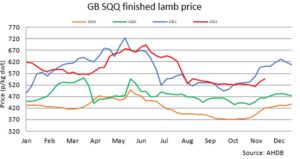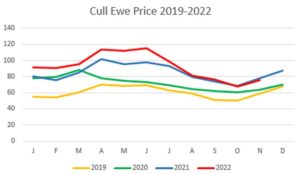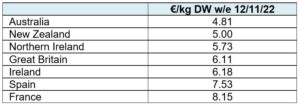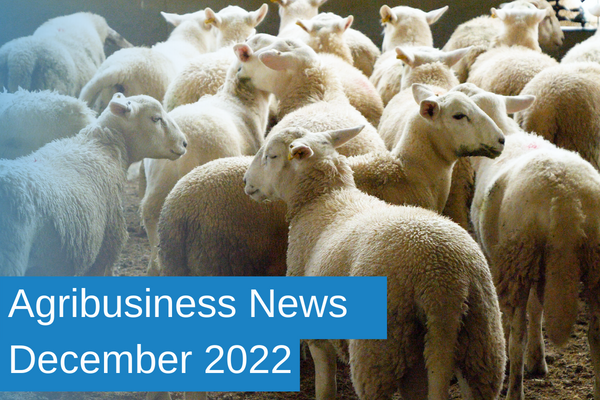Agribusiness News December 2022 – Sheep
1 December 2022The finished lamb trade has held well, compared to the high prices of 2022. It stabilised through much of October, but has shown a continual lift throughout November starting with an SQQ at the week ending 05/11/22 of 512.6p/kg to 547.2p/kg for the week ending 19/11/22. Now at the end of November the Christmas kill has started, which should further strengthen the price. Combined with a strong demand from the continent.
The live ring has shown less stability, shadowed by lambs lacking a finish coming through. Well finished lambs are and will remain to make a premium.
Cull sales
DEFRA figures show for Jan-Oct 2022 the UK adult kill of sheep to have reached 1 million, an increase of 5% compared to the same period in 2021.
The cull ewe trade has firmed again, following a very similar pattern to 2021. There are now fewer ewes coming forward as producers focus on the next breeding season, which has reduced the supply coming forward, aiding the price rise.
Global demand, price & carbon credentials
French and Spanish lamb has continued to climb in value now breaking the €8/kg barrier for French lamb. New Zealand lamb has come back in value and the price gap has reduced between Australian and NZ lamb.
Beef and Lamb NZ and the Meat Industry Association produced a document looking at the carbon footprint of exported meat. The findings were that the carbon footprint of NZ exported lamb was either lower or similar to lamb produced domestically in the countries they used as comparison. 1 kg of NZ sheep meat is reported to have a carbon footprint of just under 15 kg CO2 equivalent emissions per kg.
When comparing to other countries the report looked at the footprint associated with the footprint attached to the transporting, chilling, storage, distribution, purchase and cooking of the lamb within the destination country. The greenhouse gas emissions for these were 0.96 kg CO2 equivalent emissions per kg. Shipping contributed 43% of this, and cooking followed this at 38%.
In the document a domestically produced lamb in the UK is quoted production through to cooking as 13.88 kg CO2 equivalent emissions per kg. BLNZ_review_report.pdf (beeflambnz.com)
These figures and research are very interesting at a time when trade deals are being continued through our parliamentary process and consumer’s choices will continue to be persuaded through environmental credentials. With New Zealand’s farming systems largely being pasture based.
kirsten.williams@sac.co.uk;07798617293
Sign up to the FAS newsletter
Receive updates on news, events and publications from Scotland’s Farm Advisory Service





